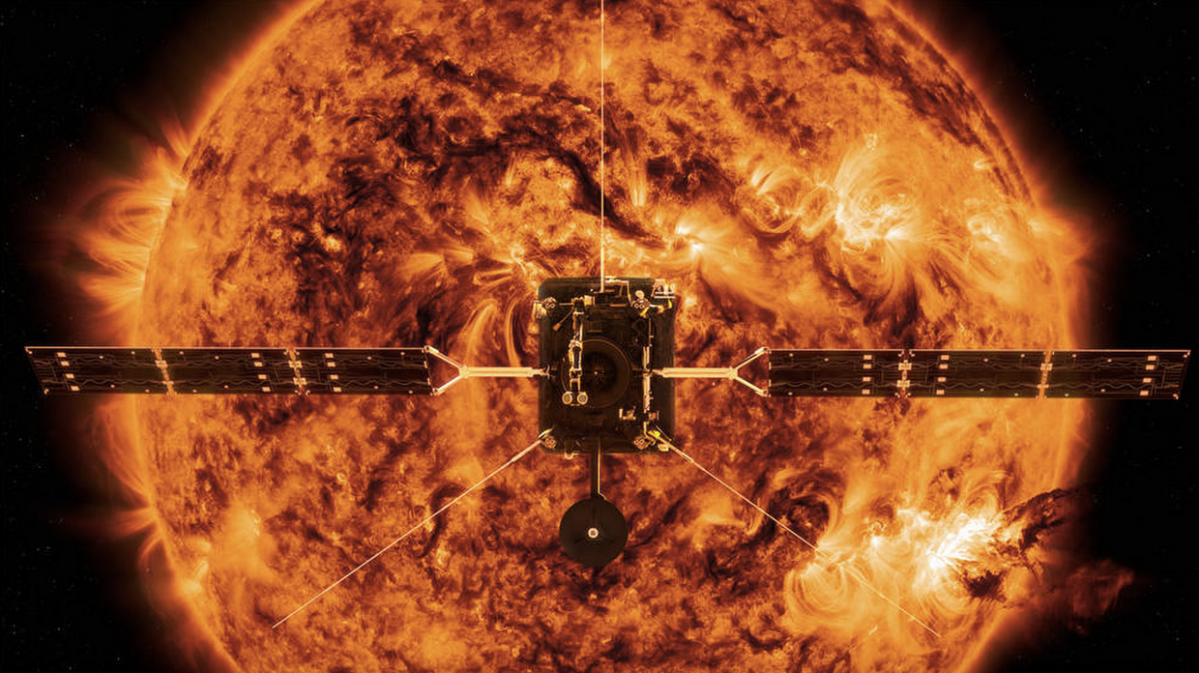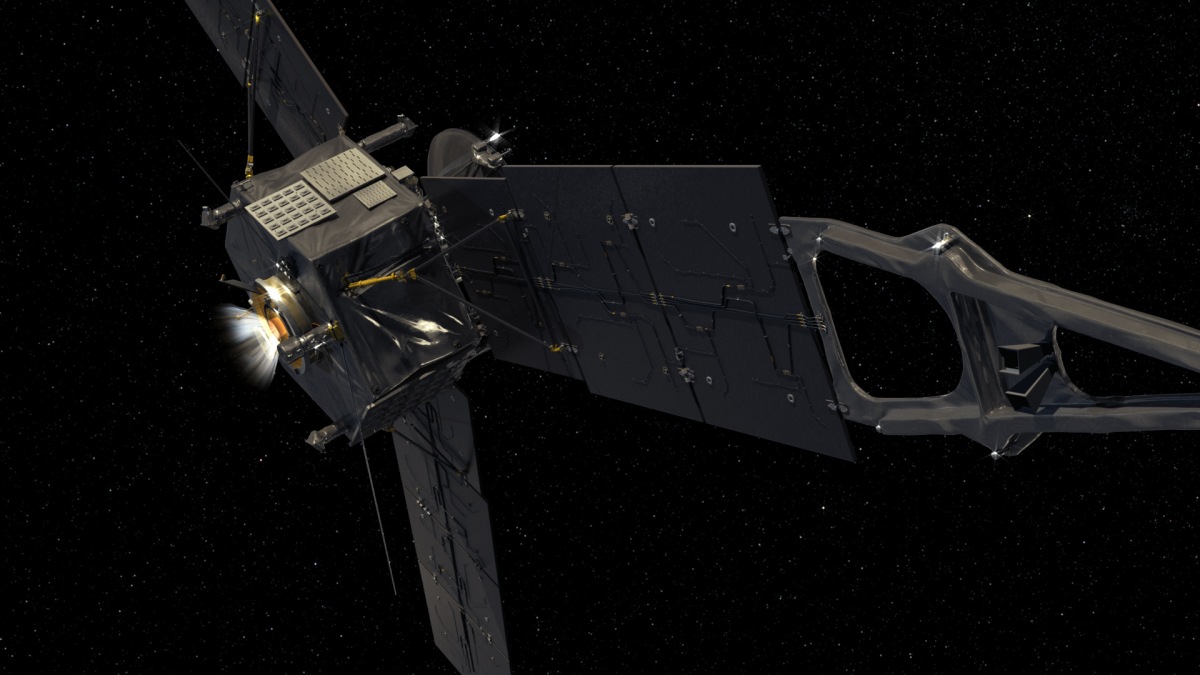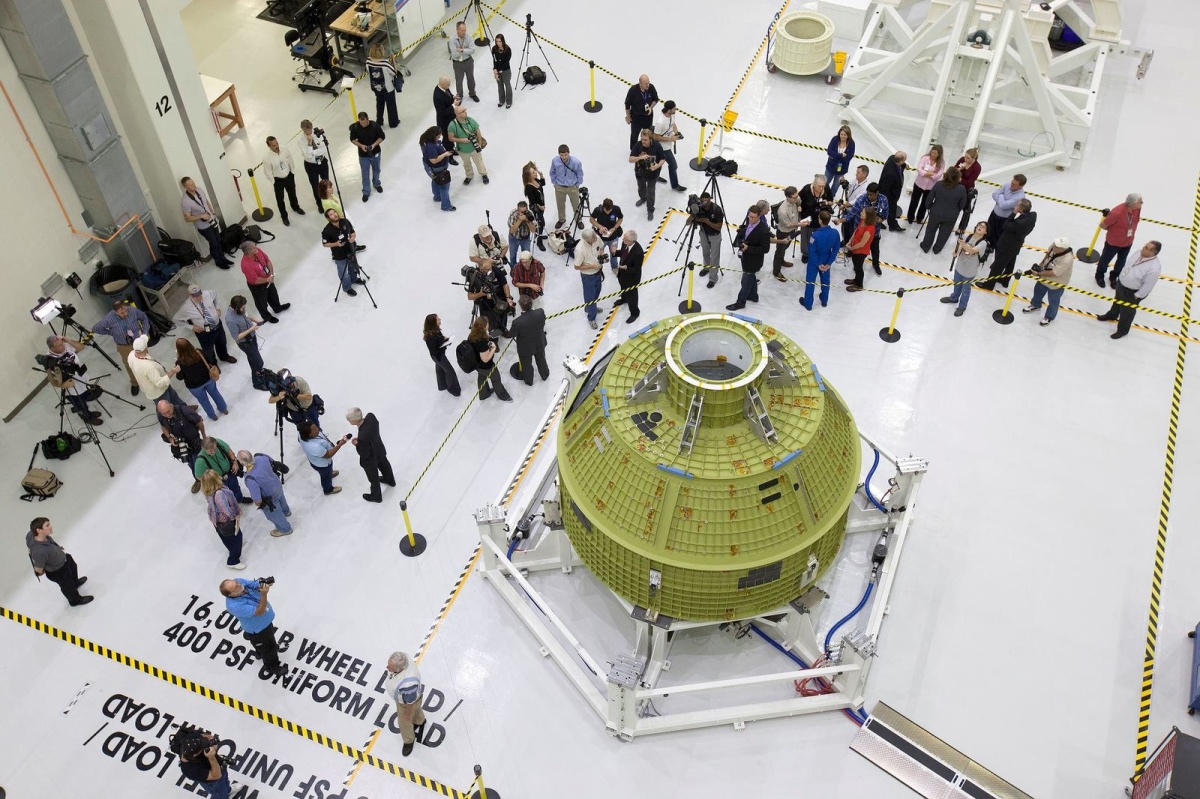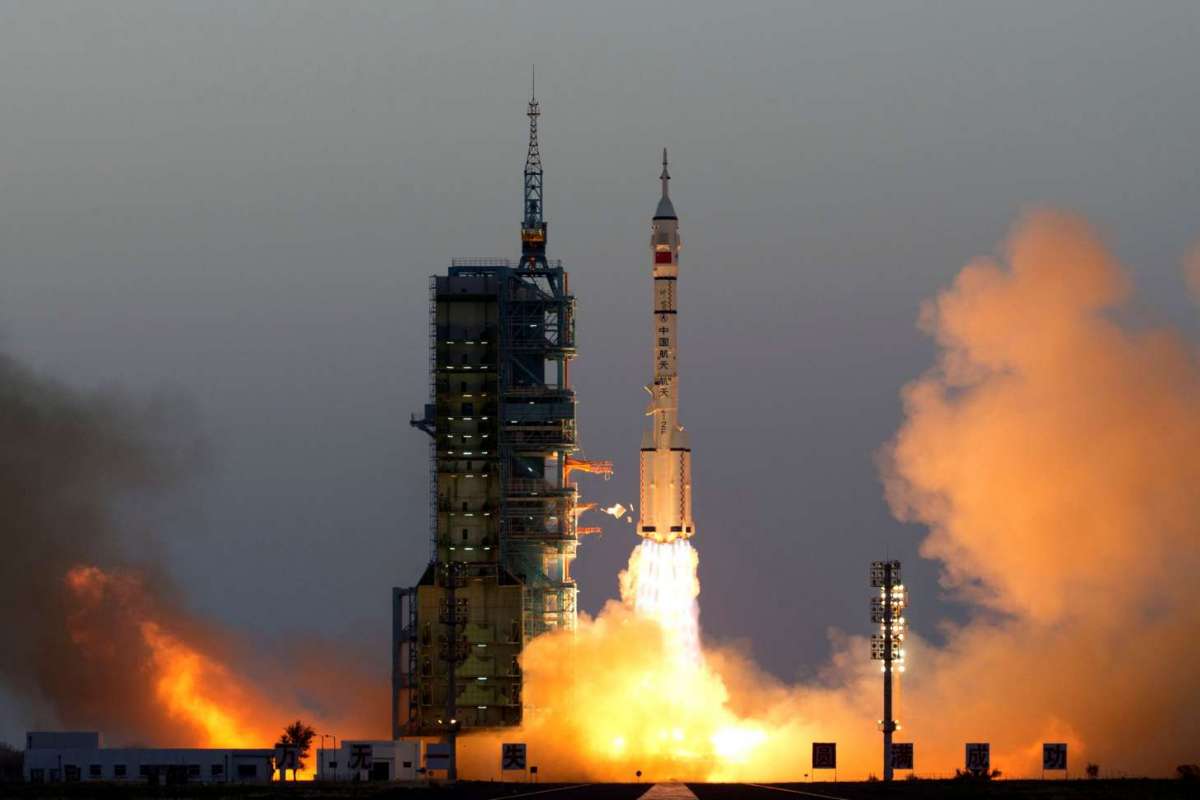July 6, 2017 by Philip Sloss

As US Vice President Mike Pence visited the Kennedy Space Center (KSC), one of the welcoming party, the Orion crew module, is fast taking shape ahead of its Exploration Mission-1 (EM-1) flight. With major processing milestones – such as the mating of the heatshield with the Crew Module, NASA managers are already thinking ahead to future flights involving Orion.
Crew Module status:
The crew module is in the Operations and Checkout (O&C) Building at the Kennedy Space Center (KSC) in Florida, where the system components are being integrated with the vehicle structure.
“The EM-1 crew module is well on its way,” Lara Kearney said in an interview with NASASpaceflight.com. Kearney is manager of the Orion Crew and Service Module Office at NASA’s Johnson Space Center in Houston, Texas.
 “The pressure vessel was down at Kennedy well over a year ago and then last summer basically was an influx of all of the components that are then assembled to that pressure vessel like the propulsion components, life support components, a lot of our landing and recovery systems like our airbags [and] our parachutes.
“The pressure vessel was down at Kennedy well over a year ago and then last summer basically was an influx of all of the components that are then assembled to that pressure vessel like the propulsion components, life support components, a lot of our landing and recovery systems like our airbags [and] our parachutes.
“So all these components were delivered over the course of this past year and then the assembly team down at Kennedy is putting it all together. The life support system is already installed, the prop system is already installed, they have been leak-checked and are ready to go. We just installed our main parachutes, so they’re stowed in the forward bay and they’re ready to go.”
With Lockheed Martin the prime contractor for Orion, the pressure vessel for the crew module is welded in an area of the expansive, multi-user Michoud Assembly Facility in New Orleans, Louisiana. The EM-1 pressure vessel is the third iteration of the structure.
 “For Exploration Flight Test-1 (EFT-1), we had eighteen welded parts [that weighed] about 3300 pounds. With Exploration Mission-1, we’re down to seven welded parts and 2700 pounds,” Kearney noted.
“For Exploration Flight Test-1 (EFT-1), we had eighteen welded parts [that weighed] about 3300 pounds. With Exploration Mission-1, we’re down to seven welded parts and 2700 pounds,” Kearney noted.
EFT-1 was the first test flight of the Orion crew module (CM) and mass simulators standing in for the service module elements in December, 2014. The first pressure vessel article built was a Ground Test Article that was used for testing at different facilities.
“It was at 31 welded parts and 3900 pounds. That was kind of the first attempt at the primary structure,” Kearney added.
 After welding was completed, the pressure vessel was shipped to KSC in early February, 2016.
After welding was completed, the pressure vessel was shipped to KSC in early February, 2016.
“We’re always dealing with mass and trying to control mass,” she noted. “As something grows, something else has to come down, but we’re getting to the point now where we’re really trying not to continue to redesign the primary pressure vessel components, simply because that just takes money to do that.
“We’re going to have to go after other components that are not yet fully designed, like the items that are coming on EM-2, like the life support components and such. Same with the heatshield, we’re trying to lock that heatshield in and not redesign it.”
Heatshield changes:
One of the major changes to the crew module between EFT-1 and EM-1 was to the base heatshield that attaches to the bottom of the crew module. The Orion crew module incorporates the same outer moldline as the Apollo command module, but is larger in size. The heatshield design that flew on EFT-1 was also ‘scaled up’ from Apollo.
 “On EFT-1, it was basically what we called a ‘monolithic’ heatshield,” Kearney explained. “There was a small honeycomb structure that covered the composite skin with hundreds of thousands of little cells that were filled with this ablative material [Avcoat] that for all intents and purposes created a single, monolithic ablative shell that covered the bottom of the heatshield.
“On EFT-1, it was basically what we called a ‘monolithic’ heatshield,” Kearney explained. “There was a small honeycomb structure that covered the composite skin with hundreds of thousands of little cells that were filled with this ablative material [Avcoat] that for all intents and purposes created a single, monolithic ablative shell that covered the bottom of the heatshield.
“We’re now using that same ablative material, but manufacturing it into these blocks and then adhering these blocks to that composite structure.
“So that’s the fundamental architecture change and ultimately we did that for a couple of reasons. One, that monolithic design was having some structural/mechanical challenges that we can overcome by going to these blocks and the block architecture is a lot less intensive from a manufacturing perspective. So it’s fundamentally a lower life-cycle cost option for us.”
 Kearney said work on heatshield assembly at KSC is progressing towards its Autumn date for integration with the Crew Module it will be tasked with protecting during re-entry.
Kearney said work on heatshield assembly at KSC is progressing towards its Autumn date for integration with the Crew Module it will be tasked with protecting during re-entry.
“The titanium structure along with the composite skin, we’ve been bonding all the tile blocks to it. All of the blocks are now on and in place and ready to go and they’re now moving into the process of what we call filling the gaps between all of those blocks and that heatshield will be installed onto the crew module in the fall time-frame.”
Although the blocks of the ablative material are fundamentally different from the insulating tiles on the Space Shuttle, they are attached to the structure and to each other in a similar fashion.
“They’re adhered by an adhesive to the underlying structure and then this gap filler is there between them to hold them all together,” she said, adding the gap filler for the Avcoat blocks was a ‘RTV-like’ material (RTV is short for Room Temperature Vulcanizer) that will cure in the gaps.
The EM-1 mission will be the first opportunity to test Orion’s re-entry to Earth’s atmosphere at lunar return speeds. The spacecraft reached a velocity of approximately 20000 miles per hour during the EFT-1 entry, descent, and landing (EDL). For re-entries from the Moon, Orion will reach speeds of approximately 25000 mph.
Service Module integration:
The EM-1 mission will exercise the new capabilities added to Orion since the short EFT-1 mission in low Earth orbit.
In contrast to EFT-1, Orion will fly with a fully functional European Service Module (ESM).
 The ESM gives Orion propulsion, power, and thermal control capabilities to allow it fly on its own into and out of lunar orbit. The ESM will also carry air and water provisions on future crewed flights.
The ESM gives Orion propulsion, power, and thermal control capabilities to allow it fly on its own into and out of lunar orbit. The ESM will also carry air and water provisions on future crewed flights.
The Orion flight software is also evolving on EM-1 to integrate and control the added capabilities, including expanded guidance, navigation, and control (GNC) functionality and communications networking needed to fly beyond Earth orbit.
A separate element, the Crew Module Adapter (CMA), sits between the CM the ESM.
“It’s the Crew Module Adapter that actually physically mates the ESA (European Space Agency) Service Module to the Crew Module and it’s through that Crew Module Adapter that all the interfaces flow, so all the gasses, power, data, all that kind of stuff flows through that adapter,” Kearney explained.
“That’s basically where our interface control is held is in that Crew Module Adapter. When the ESA Service Module comes to us, it’ll be mated within this service module structure that Lockheed is currently building down at the O&C in Florida.”
 Lockheed Martin builds those other Service Module components, the CMA, the Service Module fairing panels, and the spacecraft adapter.
Lockheed Martin builds those other Service Module components, the CMA, the Service Module fairing panels, and the spacecraft adapter.
On EM-1, launch on the Space Launch System (SLS) vehicle and Interim Cryogenic Propulsion System (ICPS) upper stage puts Orion on a week-long translunar trajectory; when the spacecraft reaches the Moon, it will fire its engines to maneuver into a Distant Retrograde Orbit.
After remaining in that orbit for approximately a week, the spacecraft will perform another set of maneuvering burns to leave lunar orbit and return to Earth about a week later.
The first ESM, Flight Model-1, is being integrated at an Airbus Defence and Space facility in Bremen, Germany. Airbus is the prime contractor for the ESM.
 As with other EM-1 spacecraft and launch vehicle elements being designed, developed, and assembled for the first time, its readiness date has been delayed, with current estimates that it will ship to KSC late this year or early next.
As with other EM-1 spacecraft and launch vehicle elements being designed, developed, and assembled for the first time, its readiness date has been delayed, with current estimates that it will ship to KSC late this year or early next.
Once the ESM arrives at KSC, it will be mated with the rest of the Service Module elements. It will be mated to the CMA and have its Orbital Maneuvering Engine (OME) nozzle re-attached. The spacecraft adapter that connects with the launch vehicle will also be attached. The integrated Service Module will then be mated to the CM, forming the “Short Stack.”
The mated spacecraft and accompanying hardware (such as Service Module fairing panels and solar arrays) will then be transported from KSC to the Plum Brook Station test facility at NASA’s Glenn Research Center in Ohio for integrated environmental testing such as vacuum and acoustic tests.
The spacecraft and hardware will then all return to KSC for final launch preparations, where the crew and service modules will be fueled with maneuvering propellant and integrated with the launch abort system for final mating to the launch vehicle.
EM-2 and beyond:
The final major development phase for Orion is planned between EM-1 and EM-2, which is the first mission that will fly crew.
Most of the Environmental Control Life Support System (ECLSS) and crew systems will be developed to integrate with the rest of the spacecraft systems for the first time.
 “Basically that’s everything that comes along with the crew – so that’ll be the flight seats, the [space]suits, the umbilicals that go along with that, all of the what we call flight crew equipment which is the stuff they carry on board with them,” Kearney explained.
“Basically that’s everything that comes along with the crew – so that’ll be the flight seats, the [space]suits, the umbilicals that go along with that, all of the what we call flight crew equipment which is the stuff they carry on board with them,” Kearney explained.
“Things like air monitors and fire extinguishers and food, water dispensers, those kind of things. The displays and controls will be new on EM-2 and then of course the life support system that is associated with the air circulating system, the carbon dioxide removal system, and the water system that’s cooling the crew will all be new on EM-2.”
The spacesuits for the early Orion missions are derived from the launch and entry suits worn by crews for most of the Space Shuttle program.
“The big difference is that Shuttle is what we called open loop — where the oxygen system flows to the suits and then the crew would breathe and then the suits would dump overboard into the Shuttle cabin,” Kearney explained.
 “On Orion, we’re [a] closed loop system, and so that’s the change from the Shuttle suits is that we’ve closed them up. We have a circulating system between the life support [system] on the crew module that flows into the suits in a closed loop.”
“On Orion, we’re [a] closed loop system, and so that’s the change from the Shuttle suits is that we’ve closed them up. We have a circulating system between the life support [system] on the crew module that flows into the suits in a closed loop.”
Although there will be little ECLSS functionality on EM-1, some hardware will fly in the crew module to collect environmental data.
“We are flying a couple of seats and some mannequins inside, collecting some radiation data on them,” Kearney added. “For the most part it’s [those] mass simulators [and] some cameras. The suited quote ‘dummies’ [are] anthropometric crash test dummy kind of things.”
For the EM-2 mission, current plans are to fly a more conservative circumlunar profile, with an extended checkout period in high Earth orbit first. If everything checks out satisfactorily, Orion would then make a single flyby of the Moon and return to Earth for splashdown.
 The other major objective for the EM-2 mission is for the SLS to put the first element of a Deep Space Gateway (DSG), a Power and Propulsion Element (PPE), on a translunar trajectory.
The other major objective for the EM-2 mission is for the SLS to put the first element of a Deep Space Gateway (DSG), a Power and Propulsion Element (PPE), on a translunar trajectory.
In what is called a “Multi Translunar Injection” (MTLI) flight profile, the SLS will perform separate burns to partially deliver Orion to one translunar trajectory and completely send the PPE to another.
After reaching an initial parking orbit around Earth, the SLS would first raise the apogee of the orbit to a high-altitude with an orbital period of about 24 hours, which will allow an extended checkout of Orion while remaining close to Earth on its first flight with crew.
Shortly after that burn ends, Orion would separate to a safe distance from SLS with the PPE. Then SLS would then restart to complete a Translunar Injection (TLI) burn with the PPE. Meanwhile, Orion would stay in the highly elliptical Earth orbit until the next day when it would perform its own burn to complete its TLI, which would put the spacecraft and crew on a free-return trajectory.
 After separating from SLS, the PPE will use its own propulsion systems once it reaches the Moon to insert itself into a Near Rectilinear Halo Orbit (NRHO), where subsequent Exploration Missions will rally with supplies and additional DSG elements.
After separating from SLS, the PPE will use its own propulsion systems once it reaches the Moon to insert itself into a Near Rectilinear Halo Orbit (NRHO), where subsequent Exploration Missions will rally with supplies and additional DSG elements.
The next Exploration Mission, EM-3, is tentatively planned to rendezvous and dock with the Power Propulsion Element in lunar orbit and Rendezvous, Proximity Operations, and Docking (RPOD) is one of the additional capabilities that will be added to Orion after EM-2.
“The plan right now is to work towards the docking capability for EM-3,” Kearney said. “We’re at the very beginning of that process,…but our budgetary plans right now are laid out to support docking on EM-3.”
On EM-3 the SLS launcher would perform a TLI burn with both Orion and a habitation module for the DSG. On their way to the Moon, the Orion would then separate from the SLS upper stage, turn around, and dock to the Hab module.
After the mated Orion and Hab module separated from the booster, they would continue into the lunar halo orbit, where they would rendezvous and dock with the PPE.
(Images: NASA, Cody Zoller and L2 artist Nathan Koga – The full gallery of Nathan’s (SpaceX Dragon to MCT, SLS, Commercial Crew and more) L2 images can be *found here*))
(To Join L2, Click Here: http://ift.tt/1pzqA43)
Share This Article





